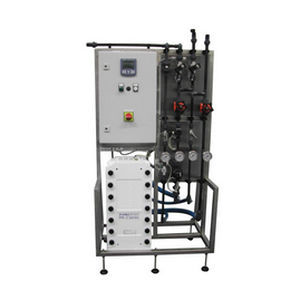Elmatec incorporates electrodeionization stacks on turnkey units to respond to your specific problems or requirements.
An electrodeionization stack is composed of cationic and anionic membranes, ion exchange resins and an anode (+) and a cathode (-) at the ends.
When an electric current is applied, the cations and anions migrate through the water to be treated. The cationic membranes let through the cations attracted by the cathode, and the anionic membranes let through the anions, attracted by the anode. The resins allow for cation and anion mobility while being continuously regenerated (formation of H+ and OH- ions as a result of the dissociation of water).
Principe EDI -
Electrodeionization removes residual salts and ionizable aqueous species such as sodium, chlorides, carbon dioxide, silica, ammonia or boron. The result is ultra-pure water with resistivity of up to 18 MΩ.cm.
EDI technology offers many advantages:
Continuous resin regeneration
No chemicals are used
Conversion rate of around 95%
Low energy and operating costs
Compact and scalable technology
Contribution to the requirements of standard ISO 14000
The continuous regeneration of the resins therefore definitively eliminates the need for regenerating acids and bases and the consequences associated with the neutralisation and disposal of regeneration waste. As chemicals are no longer required, the safety of persons and the environment is considerably improved.



